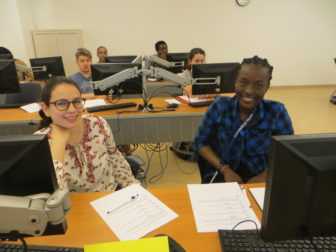The eight Ivy League universities are some of the most prestigious and competitive institutions in the world, with only a fraction of applicants admitted each year.

Michelle Muchemi
Every year, more than 300,000 students compete for a slot at the universities. The latest admission rates are Harvard University, 5.2 percent; Columbia University, 5.8 percent; Princeton University, 6.1 percent; Yale University, 6.9 percent; Brown University, 8.3 percent, the University of Pennsylvania, 9.2 percent; Dartmouth College, 10.4 percent, and Cornell University, 12.5 percent, according to Business Insider.
Each university offers an array of different opportunities based on an individual’s interest, so an Ivy League education can open doors for ambitious students.
As soon as the Common Application website opens online on August 1, students from all over the world will log on to their accounts and begin the admissions process. A stellar transcript, excellent standardized test scores, an exemplary resume, a pristine record and well-written recommendations and essays are essential to be considered by the admission counselors of these universities, according to media reports.
Overall, about 8.9 percent of all applicants to the Ivy League schools were admitted for the Fall 2015 semester, according to U.S. News & World Report. By comparison, about 66 percent of all applicants to four-year colleges and universities were admitted the year prior, according to the 2015 State of College Admission Report.
Students who apply in the Early Decision and Early Action rounds of the college application process have a higher chance of admittance in comparison to the people who apply during the Regular Decision round. Students who applied during the Early Decision round to the Ivy League institutions gained an advantage in admissions, with an admission rate of 23 percent as opposed to the 5 percent to 10 percent range during the Regular Decision rounds, according to U.S. News & World Report.
The average SAT critical reading score among freshman in the Ivy Leagues was about 721 while they scored an average of 735 on the math section. This adds up to a total score of about a 1450 on the SAT. The average ACT score was also a 33. Ninety-four percent of freshmen at Ivy League institutions were in the top 10 percent of their graduating class, according to the 2015 data in the U.S. News & World Report.
Getting into an Ivy League university can be stressful, said Marisol Dahl, a 2015 graduate of Yale from Westchester County, New York.
“I would study for 30 minutes a day for about 4 months (for the SAT),” said Dahl, whose degree is in sociology. “The application process is really stressful all during your senior year of high school, trying to figure out your life plan.”
The application process is notorious for being rigorous for many high school seniors.
“The Common Application really helped me gather my essays and recommendations so I would have time to write any of the supplemental and short answer essays most of the Ivies required,” Dahl said.
Although these top-notch universities require excellent scores and recommendations, that is not all they are looking for in an applicant. The common application offers seven essay prompts to choose from. Depending on which prompt the applicant chooses, they will be able to showcase who they are as a person.
“I feel as if the essay is what really raised my chances of being accepted into the Ivies and how I made my application stand out,” Dahl said. “I was able to show who I really am as a person through my writing skills. These colleges not only look at your score, but they look at your essay to see a shining element of what you can offer to a college community.”
To be competitive, students take many honors and Advanced Placement courses and SAT tutoring session. Others also participate in community service to round out their resumes.

Carolina Ríos and Michelle Muchemi in class.
“There was a lot of competition in my school,” Dahl said. “Everybody was in competition to beat each other and get into the Ivies.”
The competition for scholarships, extracurricular activities and the best recommendations to gain admittance into these top schools can consume students beginning in their freshman year of high school.
“I really felt the pressure to maintain the highest grades and great extracurricular activities all throughout high school because I knew that I wanted to go to an Ivy League school,” said Fidelity Ballmer, a sophomore at Brown from Ventura, California. “I knew that going to an Ivy League would be the best thing for me, so I pushed myself really hard to get into an Ivy.”
Some students, like Ballmer, apply for the Early Decision round to increase their changes of admission.
“I applied to Brown Early Decision. I was accepted, so I didn’t have to apply to any other schools through the Common Application,” Ballmer said.
Given the level of competition constantly increasing, students need back-up plans in case they aren’t admitted.
“My Plan B would have been to apply through regular decision to some of the other non-ivy league schools,” Ballmer said.
Michelle Muchemi is a student at Kennedy High School, Waterbury.